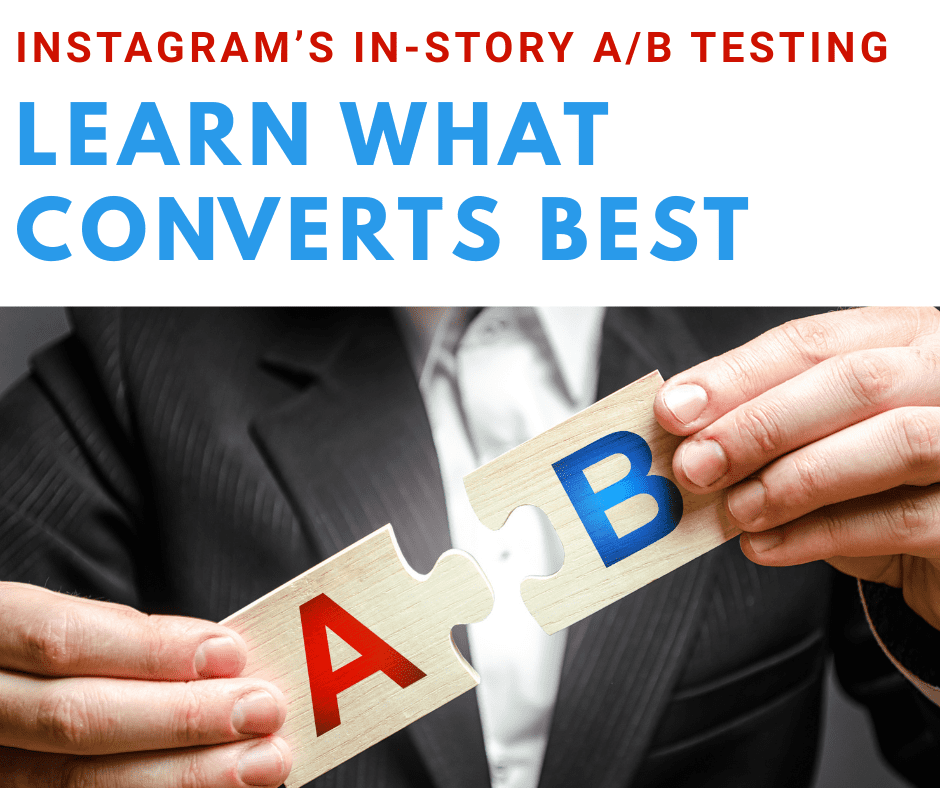Last Updated on August 7, 2025 by Val Razo
Instagram Stories have become one of the most powerful formats for connecting with your target audience—but are you truly optimizing for what works best? If you’re guessing instead of testing, you’re likely wasting ad spend and losing conversions. Learning how to use Instagram’s in-story A/B testing to learn what converts best can completely shift your social media strategy, giving you real insight into what resonates and what doesn’t.
This guide walks you through how to test on social media, track the right metrics, and apply analytics data to refine your approach. Whether you’re managing social media content for a mobile app, running Instagram ad campaigns, or simply trying to improve your Instagram stories strategy, these best practices will help you optimize every story for the best possible results.
Understanding Instagram’s In-Story A/B Testing
What Is In-Story A/B Testing on Instagram?
Instagram’s in-story A/B testing allows marketers and content creators to run two or more variations of an Instagram Story to see which one performs best. The purpose is to test on social media in a structured way, where different creative elements — such as text, stickers, visuals, or CTAs — are shown to segments of your target audience to gather comparative performance data. This technique is sometimes called split testing, and it’s an essential method for identifying what elements lead to higher conversion or stronger engagement.
Unlike random content experiments, A/B testing helps you reduce guesswork and instead rely on actual audience behavior to inform decisions.
Why You Should Test on Social Media Stories
Using A/B tests in Instagram Stories is especially valuable because Stories are short-lived, direct, and immersive. With the high visibility of the format, even small tweaks can drastically impact performance.
For example, you can try testing headline placement, emoji use, or different swipe-up CTAs to see which versions perform well. Over time, you’ll begin to understand which social media elements contribute most to a higher conversion rate or better retention.
Testing also supports optimization, helping you allocate your ad budget more efficiently by scaling only high-performing versions.
When I started A/B testing my Instagram Stories, I was promoting a mobile app. I ran two versions: one with a static image and one with a video demo. The video outperformed the static story by 3x in installs. That simple change helped cut my cost per install by nearly 40%.
Access Your Instagram for Testing Features
To begin testing, make sure you have access to either Instagram’s native analytics tools or external platforms like Facebook Ads Manager or Sprout Social. If you’re using Instagram organically (without paid promotion), you’ll need a business or creator account to unlock Instagram stories insights and analytics dashboards.
For paid story ads, go through your Facebook Business Page and navigate to using Facebook Ads Manager, where you can set up split tests within campaigns. You’ll be able to adjust placements, set testing variables, and view analytics tied to each creative variation.
Instagram Stories Strategy and Best Practices
Key Instagram Stories Strategy Tips for 2025
A strong Instagram stories strategy begins with clarity on your goals—whether it’s increasing brand awareness, improving conversion, or driving app installs. Before publishing, define what action you want viewers to take. This will help you design stories with purpose, not just aesthetics.
Keep your message short, focused, and visually appealing. Use clear CTAs, and design stories that align with your social media strategy. Make use of Instagram’s interactive features—polls, sliders, and quizzes—to boost engagement and gather feedback.
Most importantly, experiment with different formats regularly. Each story is an opportunity to learn, so don’t be afraid to vary fonts, colors, layouts, and even tone.
Best Times to Post for Maximum Engagement
Understanding the best time to post is critical to improving story performance. Instagram’s algorithm prioritizes recency, meaning your story will be seen by more users if it’s published when your audience is most active.
Use an analytics tool or analytics dashboard to review when your audience is online. Tools like Sprout Social, Instagram Insights, or native social media analytics platforms will help you uncover the best times and days to post based on actual viewing data.
Keep in mind that the “best time” can vary by industry, region, and content type—so continue to test and adjust future stories accordingly.
Instagram Stories account for over 25% of all ad revenue on Meta platforms.
Social Media Elements That Impact Performance
Design plays a huge role in whether a story will resonate with your audience. Use high-quality visuals, consistent branding, and engaging formats. Some social media content performs better when it’s raw and authentic, while other audiences prefer polished, professional designs.
Other elements to optimize include:
-
Fonts and background contrast
-
Caption length
-
Use of music or sound
-
Story pacing (how fast content progresses)
These creative elements are ideal variables for split testing—you can compare their performance over time and determine the best combination for your brand.
Story Analytics and Metrics to Track
Essential Instagram Stories Metrics to Monitor
To optimize your Instagram stories for marketing, you need to know which metrics to track consistently. The key Instagram stories metrics that reveal real performance include:
-
Impressions: How many times your story was viewed.
-
Reach: How many unique users viewed your story.
-
Taps forward/backward: Indicates engagement or confusion.
-
Exits: If users drop off your story early, the content might not be working.
-
Replies: Strong indicator of interaction and emotional resonance.
Tracking these helps you determine the most effective content and identify weak points that may be hurting conversion or engagement.
Instagram Analytics for Stories: Tools and Dashboards
There are multiple ways to view analytics and gather insights on story performance. If you have a business or creator account, use native Instagram analytics under your Instagram Insights tab.
For deeper visibility, consider tools like:
-
Facebook Ads Manager
-
Sprout Social
-
Social’s Instagram dashboard
-
Third-party analytics platforms that allow detailed dashboard views
These tools show how individual stories perform over time, and let you analyze social media data across campaigns, not just individual posts.
Brands using A/B testing in Instagram Stories saw up to a 20% increase in conversion rates.
How to Analyze Social Media Data Effectively
Once you collect data, it’s time to put it to use. Focus on trends, not one-off spikes. For example, if Stories with video content consistently show higher story performance, that’s a cue to create more of that format.
Here’s how to refine your Instagram efforts:
-
Track metrics like replies or exits to improve content flow.
-
Use analytics to refine CTAs and visual styles.
-
Apply data insights to future stories accordingly.
The ultimate goal is to identify the story elements that lead to better ROI, engagement, and retention—then scale those across your social media platforms.
Optimizing Story Ads and Conversion Funnels
Using Facebook Ads Manager for Stories A/B Testing
When running paid Instagram ad campaigns, your best friend is Facebook Ads Manager. This tool allows you to set up split testing directly within your ad sets. You can test variables like visuals, text, call-to-action buttons, and even landing page destinations to see which one drives better results.
Make sure your ad campaign objectives are clear — whether it’s app installs, lead generation, or purchases. With precise goals, testing helps you pinpoint what truly works at every stage of the funnel.
Using the using Facebook Ads Manager platform also gives access to advanced reporting, letting you monitor the performance of each creative variation and compare their performance across multiple metrics.
Instagram Stories Ads: Formats That Convert
The format of your stories ads can make or break your results. High-converting stories are usually:
-
Vertical, full-screen visuals (1080×1920 resolution)
-
Fast-paced with dynamic elements
-
Including clear CTAs like “Swipe Up” or “Tap to Learn More”
You should experiment with different types of content including:
-
Static images vs video
-
User-generated content vs branded assets
-
Product demos vs lifestyle shots
This will help you discover which formats perform well with your target audience, especially when promoting a mobile app or pushing to an app store product page.
I used to post Instagram Stories randomly throughout the day, but after using a scheduling tool and analyzing my engagement times, I switched to consistently posting at 11 a.m. and 8 p.m. My story views jumped by 30%, and I started getting more replies from viewers.
How to Optimize for Better ROI and Conversion
Optimization isn’t just about the creative—it’s about performance. Use analytics data from your campaigns to adjust everything from timing to design. You can also:
-
Reallocate ad spend to top-performing variants
-
Pause ads with low engagement or high cost-per-click
-
Use detailed analytics to guide future social media content
Ultimately, the goal is to increase your conversion rate while reducing waste in your ad budget. With the right data and tools, you can determine the most effective approach and optimize for long-term success.
Applying Data to Broader Social Media Strategy
Leveraging Story Data Across Your Social Media Strategy
Your Instagram stories data shouldn’t live in a silo. The insights you gather can fuel your entire social media marketing approach. If certain story formats or topics are performing well, incorporate similar tactics across Reels, feed posts, or even other social media platforms like TikTok or Facebook.
Use this data to:
-
Guide your social media strategy
-
Inform brand messaging and content themes
-
Build stronger cross-platform campaigns
When you consistently analyze social media results, you can create smarter strategies that are both creative and data-driven.
Connecting Instagram Metrics to Mobile App and App Store Goals
If you’re marketing a mobile app, your Instagram stories for marketing can directly impact your app store listing performance. Story ads that drive users to an app store product page should be tested and refined just like other acquisition funnels.
Here’s how to align story analytics with app growth:
-
Track which stories generate the most app clicks or installs
-
Test CTAs that lead to the App Store and Google Play
-
Optimize your app store optimization efforts by using creatives that reflect what converts in stories
Integrating Instagram performance data with your app marketing goals helps ensure consistency across user touchpoints — and keeps your conversion funnel tight and effective.
How to Analyze App Store and Google Play Campaign Results
Don’t forget to review how your Story-driven campaigns translate to installs, in-app actions, or purchases. Use tools like Appsflyer, Adjust, or Apple/Google console dashboards to track performance from story to store.
Look for insights such as:
-
Which story ad drove the most installs?
-
What content had the highest engagement but lowest conversion rate?
-
Which social proof elements in your creative may have influenced trust?
By comparing this data with your Instagram analytics for stories, you can make smarter content and advertising decisions — and refine every campaign for best results.
Conclusion
Understanding how to use Instagram’s in-story A/B testing to learn what converts best gives you a powerful edge in the competitive world of social media marketing. By tracking the right metrics, using the right analytics tool, and optimizing your social media content, you can turn Instagram Stories into a high-performing asset in your marketing funnel.
From creative tweaks to conversion improvements and cross-platform insights, testing empowers you to stop guessing and start scaling what works. Whether you’re promoting a mobile app, refining your Instagram stories strategy, or improving your ROI, every experiment brings you closer to actionable results.
Start small, experiment with different elements, and watch your story performance evolve with smarter data-backed decisions.
Frequently Asked Questions
How can I test different story formats on Instagram?
To test different formats, use A/B testing tools within Facebook Ads Manager or third-party platforms. Try variations of text, visuals, and CTAs to see which formats generate the best engagement or conversion. Don’t forget to track performance using Instagram stories analytics to validate your findings.
Can you see who viewed your Instagram Story?
Yes, if you have a personal or Instagram account (not a business page), you can tap your story and swipe up to see who viewed your story. For business accounts, deeper analytics are available through Instagram Insights or external tools to understand Instagram stories performance.
How do I use Instagram Stories to support my app marketing strategy?
To promote your mobile app, use Instagram advertising with Story ads that link directly to your App Store or Google Play listing. Use A/B testing to find the best performing creatives, then scale campaigns that deliver installs. Make sure your story design highlights benefits that make your app stand out.
What’s the best way to schedule Instagram Stories for higher ROI?
To schedule Instagram Stories, use tools like Meta Business Suite, Later, or Buffer. Scheduling allows you to post at the best times, test consistently, and ensure your content aligns with your Instagram marketing strategy for improved results and visibility.
How do I turn Instagram Stories insights into long-term strategy?
Use your Instagram stories analytics to identify trends—like what topics, visuals, or CTAs generate the most engagement. Then, incorporate these findings into your long-term Instagram strategy, adjusting your content calendar, ad creatives, and even messaging across all platforms.
Author Bio
Val Razo
Val Razo is a skilled professional in the field of Instagram Marketing. With over five years of experience as a freelance Social Media Marketing consultant, Val has assisted numerous small and medium-sized businesses in achieving their goals.





